AMD Radeon HD 7870 GHz Edition & Radeon HD 7850 Review: Rounding Out Southern Islands
by Ryan Smith on March 5, 2012 12:01 AM ESTOverclocking: Power, Temp, & Noise
As with the rest of Southern Islands, AMD is making sure to promote the overclockability of their cards. And why not? So far we’ve seen every 7700 and 7900 card overclock by at least 12% on stock voltage, indicating there’s a surprising amount of headroom in these cards. The fact that performance has been scaling so well with overclocking only makes overclocking even more enticing. Who doesn’t want free performance?
So how does Pircairn and the 7800 series stack up compared to the 7700 and 7900 series when it comes to overclocking? Quite well actually; it easily lives up to the standards set by AMD’s previous Southern Islands cards.
| Radeon HD 7800 Series Overclocking | ||||
| AMD Radeon HD 7870 | AMD Radeon HD 7850 | |||
| Shipping Core Clock | 1000MHz | 860MHz | ||
| Shipping Memory Clock | 4.8GHz | 4.8GHz | ||
| Shipping Voltage | 1.219v | 1.213v | ||
| Overclock Core Clock | 1150MHz | 1050MHz | ||
| Overclock Memory Clock | 5.4GHz | 5.4GHz | ||
| Overclock Voltage | 1.219v | 1.213v | ||
Overall we were able to push our 7870 from 1000MHz to 1150MHz, representing a sizable 15% core overclock. This is now the 3rd SI card we’ve hit 1125MHz or 1150MHz – the other two being the 7970 and the 7770 – so AMD’s overclocking headroom has been extremely consistent for their upper tier cards.
As for memory overclocking, we hit 5.4GHz on both cards before general performance started to plateau, representing a 12.5% memory overclock. Considering that both cards use the same RAM on the same PCB, and the performance limitation is the memory bus itself, this is consistent with what we would have expected. With that said, we are a bit surprised that we got so far over 5GHz on 2Gb GDDR5 memory chips only rated for 5GHz in the first place; it indicates that Hynix’s GDDR5 production very mature.
With that said, because of the unique and non-retail nature of the 7850 AMD supplied us, the 7850 overclocking results should be considered low-confidence. The retail 7850 cards will be using simpler and no doubt cheaper coolers, PCBs, and VRMs; all of these can reduce the amount of overclocking headroom a card has. It’s by no means impossible that a 7850 could hit 1050MHz/5.4GHz, but it’s far more likely on a 7870 PCB than it is on a 7850 PCB.
Anyhow we’ll take a look at gaming performance in a moment, but in the meantime let’s take a look at what our overclocks do to power, temperature, and noise.
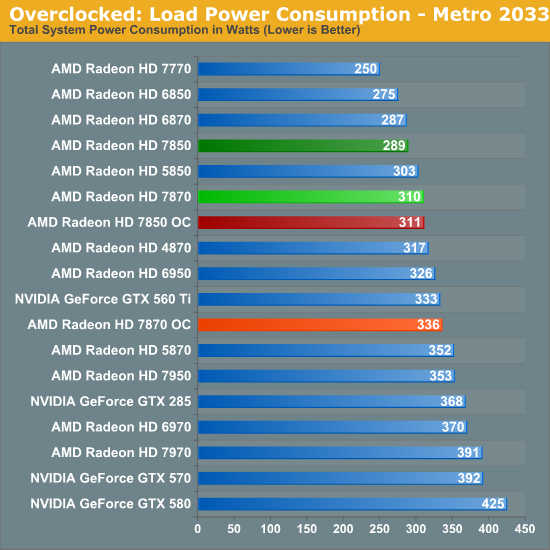
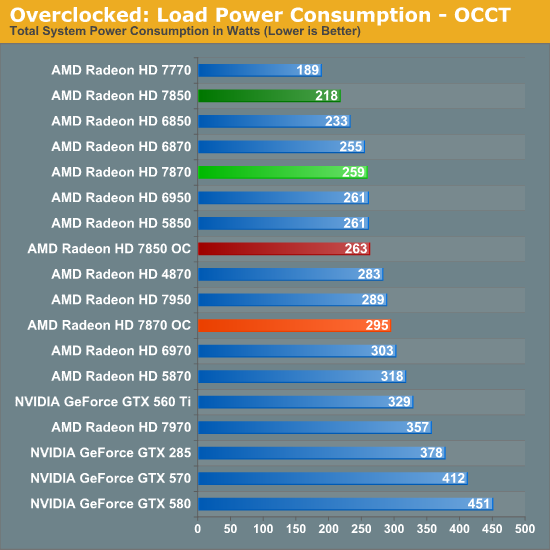
Even without a voltage increase overclocking does cause power consumption to go up, but not by a great deal. Under Metro the total difference is roughly 21W for the 7850 and 25W for the 7870, at least some of which can be traced back to the increased load on the CPU. Whereas on OCCT there’s a difference of nearly 40W on both cards, thanks to the increased PowerTune limits we’re using to avoid any kind of throttling when overclocked. All things considered with our overclocks power consumption for the 7850 approaches that of the 7870 and the 7870 approaches the GTX 560 Ti, which as we’ll see is a fairly small power consumption increase for the performance increase we’re getting.
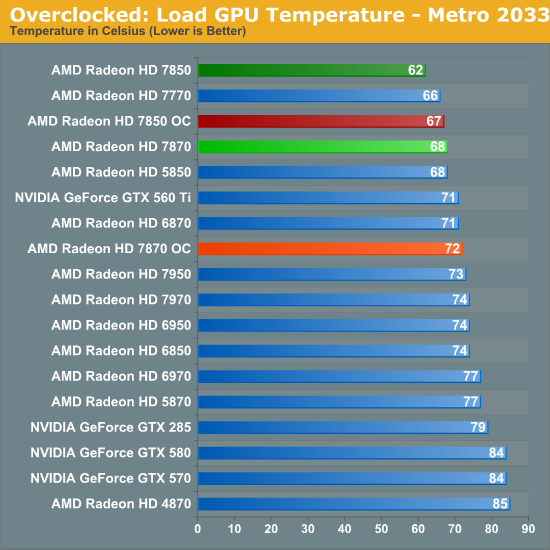
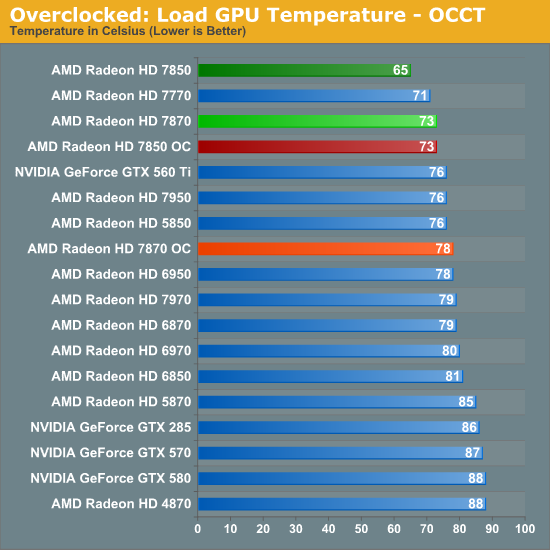
Of course when power consumption goes up so does temperature. For both cards under Metro and for the 7870 under OCCT this amounts to a 5C increase, while the 7850 rises 8C under Metro. However as with our regular temperature readings we would not suggest putting too much consideration into the 7950 numbers since it’s using a non-retail design.
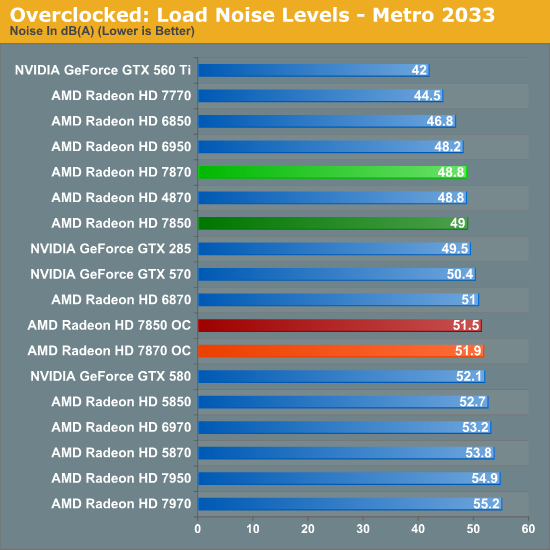
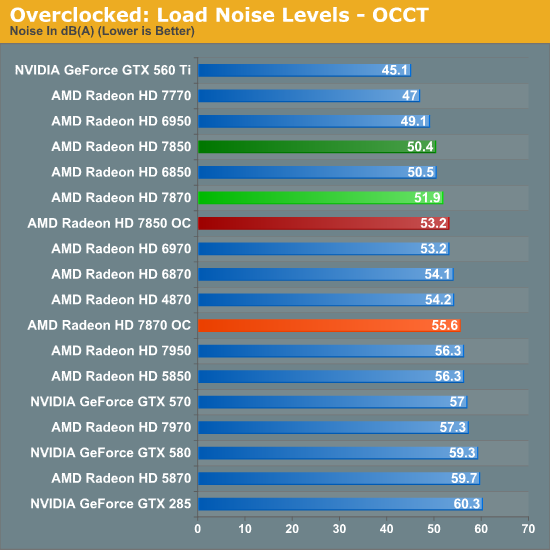
AMD’s conservative fan profiles mean that what are already somewhat loud cards get a bit louder, but in spite of what the earlier power draw differences would imply the increase in noise is rather limited. Paying particular attention to Metro 2033 here, the 7870 is just shy of 3dB louder at 51.9dB, while the 7850 increases by 2.7dB to 51.5dB. OCCT does end up being worse at 2.8dB and 3.7dB louder respectively, but keep in mind this is our pathological case with a much higher PowerTune limit.










173 Comments
View All Comments
Beenthere - Tuesday, March 6, 2012 - link
Yes at the moment AMD is most definitely getting top dollar for these Vid cards just as Intel does all of the time on their CPUs - until they have competition.In case you didn't notice the new 7xxx series cards surpass Nvidia's current offerings in just about every category so this IS a step forward in performance at the same or lower prices.
MMoudry - Tuesday, March 6, 2012 - link
Hello,Does anybody know if those two cards would work in crossfire? The Crossfire compatibility chat is not yet up to date and I can't seem to find that information anywhere....
Sources:
http://sites.amd.com/us/game/technology/Pages/cros...
MM
Hrel - Tuesday, March 6, 2012 - link
Hd6870 and gtx 560 can be had for 160 and 165 respectively. WHY would anyone want the SIGNIFICANTLY slower 7770? It's not like it's directX 12 or something.Alpert - Tuesday, March 6, 2012 - link
I can understand why so many get it wrong but I can also clearly see.7770 currently retails for $169.99 - $179.99
6870's currently retail for $189.99 - $209.99 original price was $249.99
I just checked these numbers from 3 retailer
7770 is a weaker card then the 6870, sure but performance per dollar is actually a little better with the 7770. Considering the lack of competition from Nvidia why would AMD reduce the price to performance ratio that exists. AMD is selling you more features for a better value card.
When Kepler arrives AMD price's could go down if Nvidia prices it that way. If Kepler is all the #$%^ it's hyped to be AMD will counter it with a price drop then we all win. Looking at ATI/AMD's history something they have always offered the customer, superior price/performance of the competition.
AMD will always be better price to performance for less while Nvidia justifies there inflated prices with CUDA, PhysX, TWIMTBP and of course better driver support.
The value of performance will remain as is. Like a commodity on the stock exchange, why would Nvidia devalue there own stock or at least so quickly?
Hrel - Wednesday, March 7, 2012 - link
I checked the prices I listed on newegg just before posting that. Not sure where you got your prices from, but shop newegg in the future... that way you aren't wrong :p.bozolino - Tuesday, March 6, 2012 - link
There is something REALLY odd about 560 TI numbers on ELDERS SCROLL V.Under 7770 REVIEW it shows 7770 right above 550 TI and on the top of all them is a standard GTX 560 with like 46 fps and here, on this review it shows the GTX 560 TI with like 36 fps. The settings look just like the same..
Please correct that because it is looking like the GTX 560 TI is worse than the 7770, wich it isnt by at least a mile.
Alpert - Tuesday, March 6, 2012 - link
With a 7770 the power consumption is below that of the Radeon HD 6870 and GeForce GTX 560 Ti, while still delivering the same gameplay experience of those video cards. About 2%-7% slower then 560 Ti.CeriseCogburn - Thursday, March 8, 2012 - link
This isn't HardOCP Alpert.slypher1024 - Wednesday, March 7, 2012 - link
My 5850 still server me well @ 1600x900 res.. Not until these prices drop i'll upgrade..AMD is obviously maximizing profit with these products, seeing that Nvidia next launch is at least 2 months away...
SAD
gammaray - Wednesday, March 7, 2012 - link
Price wars, really?seriously, 250$ for a low end video card and 350$ for a mid range video card, not even the MAIN LINE serie but somewhat weaker versions of their 7900 serie counterpart.
Video card markets have been ripping off consumers in the past years with their super hefty high prices.
it should be like that: 150$ for new low end video cards, 250$ for new mid-range and 350$+ for whatever they want to sell to whoever will always buy the most expensive stuff no matter.
the price of the 6800 should all be below 100$ right now and the 6900 serie prices cut in half .